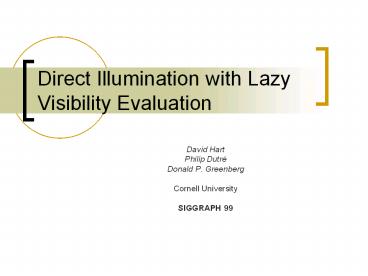Direct Illumination with Lazy Visibility Evaluation PowerPoint PPT Presentation
Title: Direct Illumination with Lazy Visibility Evaluation
1
Direct Illumination with Lazy Visibility
Evaluation
- David Hart
- Philip Dutré
- Donald P. Greenberg
- Cornell University
- SIGGRAPH 99
2
Motivation
- To compute the direct illumination in a
three-dimensional scene - Determines the visibility between any surface
point and an area light source. - An efficient processing of the visibility
function is often the key for rendering fast and
accurate soft shadows. - Integrates the incoming radiance function due to
the light source.
3
Distinguishing Features
- Two phases
- Visibility function
- Rendering equation
- The visibility pass detects blocker-light source
pairs. - Do NOT construct a complete discontinuity mesh in
object space. - The second phase clips the light sources
according to the stored blockers. - The remaining light source area defines the
integration domain for the illumination integral. - We store no visibility information that will not
be needed during the illumination computations.
4
Rendering Equation
- Too complex!
5
Analytic Integration
- The luminaires are a (disjoint) set of polygons.
- The exitant radiance is a constant for a given
light source. - The receiving surface is diffuse.
- Use Stokes theorem
6
Monte Carlo Integration
- Regardless of the type of BRDF.
- Domain reduction
- A fraction of the generated samples will evaluate
to zero causing significant noise in the image. - A reduction of the integration domain to the
visible parts of the light sources would decrease
noise significantly. - Solid angle sampling
- The integration domain can be transformed from
the area of the light sources to the solid angle
subtended by the light sources on the hemisphere
around.
7
Construction of The Blocker-Map
8
Construction of The Blocker-Map
- Shadow rays
- A ray is cast through the center of each pixel
find the nearest visible point and a number of
shadow rays starting from that point are
generated for each light source. - If one of these rays hits an intervening object,
this blocker-light source pair is stored. - Flood-fill algorithm
- The blocker is projected onto the light source
and neighboring pixels are examined. - If the two polygons (blocker and light source)
overlap, the pair will be added to the
blocker-map.
9
Blocker-Map
10
Anti-Aliasing
- If more than one ray per pixel is generated for
illumination computations as part of an
anti-aliasing algorithm. - The blocker-light source list might be invalid.
- The surface points might be located in very
different positions in object space. - The coherency of the penumbra regions over the
image plane can again be exploited. Due to the
flood-fill, we know that a blocker is at least
valid for the center location of all covered
pixels. Blah blah - If we allow the flood-fill algorithm to include
the boundary pixels for which the flood-fill test
fails, we can safely assume that we have stored
all possible blockers. - To generate multiple sample rays for illumination
computations, without increasing the number of
rays used for constructing the blocker-map. - High-frequency geometry, such as small objects,
might be overlooked.
11
Discussion
- Missing blockers.
- Increases the number of shadow rays.
- Concludes any rather than the nearest
intersecting polygon. - Receiver surfaces.
- Produces soft shadows on any surface type.
- Small blockers.
- Clip a very small piece of the light source.
- A whole set of small blockers might significantly
affect the visibility of a light source, thus
they cannot be ignored. - Requires a full clipping operation.
- This is a worst-case scenario for our current
algorithm.
12
Results
13
Results
14
Results
15
Results
16
Results

